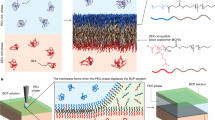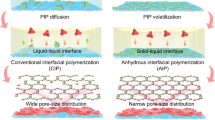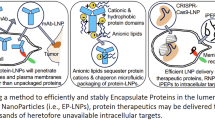Abstract
The interaction between an anionic amphiphilic sequential polypeptide and an anionic bilayer membrane composed of sodium dilaurylphosphate (DLPNa) was investigated and compared with hydrophobic polypeptide–DLPNa bilayer membrane and anionic polypeptide–DLPNa bilayer membrane interactions. A hydrophobic polypeptide, poly(γ-methyl L-glutamate) (PMG, M̅v=4400), was incorporated into the DLPNa bilayer membrane due to their hydrophobic interaction. The incorporation of PMG, however, did not effectively increase sodium ion permeability across the DLPNa bilayer membrane. There was no appreciable interaction between an anionic polypeptide, poly(L-glutamic acid) (PGA, M̅v=9200), and anionic DLPNa bilayer membrane because of Coulombic repulsion. On the other hand, an anionic amphiphilic sequential polypeptide, poly(γ-methyl L-glutamate-co-L-glutamic acid) (am.-MG/GA), of molecular weight 4300 whose α-helix was anionic on one face consisting of L-glutamic acid and hydrophobic on the opposite face comprising of γ-methyl L-glutamate was easily incorporated into the anionic DLPNa membrane and remarkably increased sodium ion permeability based on a transmembrane bundle consisting of amphiphilic helical rods. It was shown, moreover, that lithium ion apparently decreased the sodium ion permeation through the DLPNa bilayer membrane containing am.-MG/GA.
Similar content being viewed by others
Log in or create a free account to read this content
Gain free access to this article, as well as selected content from this journal and more on nature.com
or
References
M. Higuchi, T. Kinoshita, A. Takizawa, Y. Tsujita, and K. Okochi, Macromolecules, 23, 361 (1990).
O. F. Robert, Jr. and M. R. Frederic, Nature, 300, 325 (1982).
D. W. Urry, T. L. Trapane, and K. U. Prasad, Science, 221, 1064 (1983).
M. T. Tosteson and D. C. Tosteson, Biophys. J., 36, 109 (1981).
H. Vogel and F. Jahnig, Biophys. J., 50, 573 (1986).
M. Noda, H. Takahashi, T. Tanabe, M. Toyosato, S. Kikyotani, Y. Furutani, T. Hirose, H. Takashima, S. Inayama, T. Miyata, and S. Numa, Nature, 302, 528 (1983).
J. F. Moor and R. M. Stroud, Proc. Natl. Acad. Sci. U.S.A., 81, 155 (1984).
P. R. Schofield, M. G. Darlison, N. Fujita, D. R. Burt, F. A. Stephenson, H. Rodriguez, L. M. Rhee, J. Ramachandran, V. Reale, T. A. Glencorse, P. H. Seeburg, and E. A. Barnard, Nature, 326, 221 (1987).
C. H. Banford, A. Elliot, and W. E. Hanby, “Synthetic Polypeptides,” Academic Press, New York, N.Y., 1956.
H. Kumehara, T. Kasuga, T. Watanabe, and S. Miyata, 4th International Conference on L-B Films, 1989, p. 226.
A. Takizawa, M. Higuchi, T. Kinoshita, and Y. Tsujita, Colloid. Polym., 265, 31 (1987).
J. L. Houben, A. Fissi, D. Bacciola, N. Rosato, O. Pieroni, and F. Ciardelli, J. Biol. Macromol., 5, 94 (1983).
P. B. Ghosh and M. W. Whitehouse, Biochem. J., 108, 155 (1968).
M. Higuchi, T. Kinoshita, A. Takizawa, and Y. Tsujita, Polym. J., 21, 295 (1989).
G. K. Radda, Biochem. J., 122, 385 (1971).
E. M. Kosower, J. Am. Chem. Soc., 80, 3253 (1958).
D. C. Turnner and L. Brand, Biochemistry, 7, 3381 (1967).
R. W. Hay, “Bio-inorganic Chemistry,” Ellis Horwood, England, 1984.
Author information
Authors and Affiliations
Rights and permissions
About this article
Cite this article
Higuchi, M., Kinoshita, T., Takizawa, A. et al. Interaction between an Anionic Amphiphilic Sequential Polypeptide and Anionic Bilayer Membrane. Polym J 23, 15–22 (1991). https://doi.org/10.1295/polymj.23.15
Issue date:
DOI: https://doi.org/10.1295/polymj.23.15



